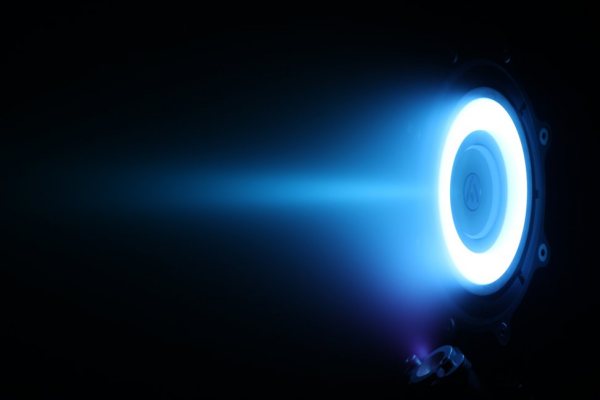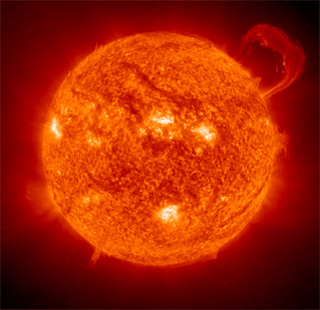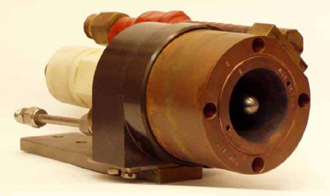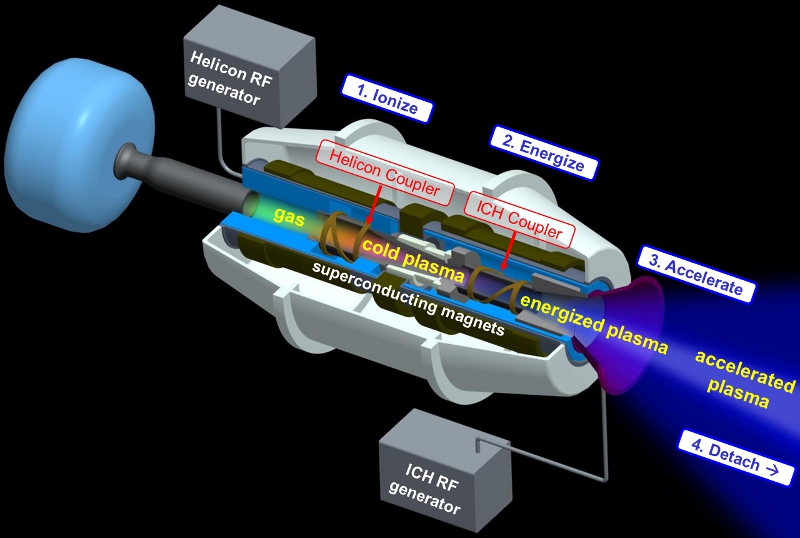
Fig. 1: Representational Image of Electric Propulsion
Humans can walk on land in the absence of automobiles, they can swim in the water without boats, but without planes and rockets, we cannot fly. Leaving the ground is in defiance with the gravitational pull of the earth and therefore requires a certain work needs to be done by a body to propel it. This propulsive force is known as ‘thrust’. If we consider a rocket for example, when it lifts off, chemical reactions take place in its combustion chamber producing large amounts of trapped energy which explodes out at high speeds through a nozzle and exerts force on the atmosphere. The atmosphere reacts in accordance with newton’s third law to push the rocket upwards. Space exploration in the 1900s was more of a government affair, whereas the 21st century is seeing more and more participation of private sectors as innovations rise in the aerospace sector from companies such as SpaceX, Boeing, Virgin Galactic, The Spaceship Company (TSC) etc. The costs of sending a payload into space is massive and is therefore not opted as a viable front for open research. There are many reasons for such high costs like thousands of tons of fuel, state of the art electronics and control systems, precision manufacturing of large parts, non-reusability of the launch vehicles. In this article we discuss about a technology that may quite well replace the conventional chemical rocket propulsion and in what ways it is better and what it lacks from its competition.
Preview – Rocket Propulsion
So what exactly is the term propulsion? We immediately picture a big exhaust plume coming out from a rocket, but why do we need that thrust? The answer is, to achieve acceleration. Acceleration can be used to move a body from rest, change the velocity of a body or overcome various drag (retarding) forces. Rocket propulsion is a sub category of jet propulsion where propulsion is achieved by ejecting a stored mass (propellant) at high velocities.
Conventionally rocket propulsion is achieved by chemical combustion. In these chemical rocket propulsion systems, there are two separate tanks containing the fuel and the oxidizer. These are fed into a combustion chamber at high pressures. At this high the pressure the mixture ignites and heats the gas to extremely high temperatures causing the gas to expand. This is passed through a nozzle where all this pressure energy is converted into kinetic energy causing it to come out at extremely high velocities (up to 5000 meters/sec). Chemical propulsion systems are classified in to Solid Propellant Chemical Rocket Propulsion, Liquid Propellant Chemical Rocket Propulsion and Hybrid Rocket motors. The solid rocket motors are the most primitive system where a hollow cylinder of solid fuel is ignited to heat and expand the gas in the hollow region (similar to the rockets used in fireworks). The more complicated and advanced rocket propulsion system is the liquid rocket propulsion system where liquid forms of fuel and oxidizers are controlled by motors, by controlling the feed, the rate of combustion is controlled therefore giving us control of the thrust. The hybrid rocket motor is a combination of both solid and liquid system where a liquid oxidizer and a solid fuel is used.

Fig. 2: Diagrammatical Image of Liquid Rocket Motor

Fig. 3: Diagrammatical Image of Solid Rocket Motor
Although chemical propulsion systems are known for producing high quantities of thrust, they get used up pretty quickly. So to fulfill a required mission a lot of fuel is consumed (thousands of tons). Here enters the concept of electric propulsion which greatly reduces relative propellant consumption while giving high exhaust velocities.
Introduction
Electric Propulsion – Introduction

Fig. 4: Plasma Globe

Fig. 5: Sun
First we need to understand a concept called specific impulse (Isp). It is the total impulse per unit weight of the propellant. It directly relates to the thruster’s efficiency. In can be thought of as synonymous to what mileage is to an automobile. If less weight can give more thrust in a given time (high specific impulse) then lesser fuel is consumed. In chemical propulsion we try to extract the internal energy of a propellant by combusting it and breaking bonds (which is mostly limited or not fully extracted). But what if we could take a propellant and supply with external energy with no theoretical limit. More the energy content more work can be done. This is the basic goal of electric propulsion.
Electric propulsion, as the name suggests, uses electrical energy (external source) to heat and eject the propellant. Further, when a gas is placed in a strong electric field, its positive and negative elements split up creating a pool of charge (where the positive charge is equal to the negative charge). This new physical state of the gas is called a ‘Plasma’ and the process is called ‘Ionization’. It is fluidic like a gas, but it reacts to electric and magnetic fields (since it contains charged particles) and can be manipulated by these fields. So, the plasma generated by the electric field is accelerated through a magnetic field and exhausted at extremely high velocities (up to 100,000 m/sec). The greater the electrical energy provided, the greater will be the current density causing a stronger magnetic field and hence a faster exhaust velocity. The concept of electric propulsion was first conceived by the father of Liquid Propulsion, “Robert Goddard” in 1906 in USA although its development started in the later part of the 19th century by NASA and ESA. Today, advanced concepts of plasma thrusters are being researched to enable deep space missions.
The Plasma Thruster
Now that we have seen the science behind electric propulsion, let us delve into the engineering part of designing a basic plasma thruster. Applying this principle into making a tangible product can be done in more than one ways. But what every system requires are these four basic sub systems
-
An energy source (Solar energy, nuclear energy or exotic matter)
-
A conversion system (to convert the source energy in to electrical energy)
-
A propellant system (to store, meter and deliver the propellant)
-
A thruster device (where the electrical energy is converted to kinetic energy)
The selection of propellant is quite important. It should be an inert gas so as to not react with the atmosphere of the nozzle. It should preferably be monoatomic since extra energy is required to break inter molecular bonding. The most common propellants used in electric thrusters are Argon, Neon, Xenon, Helium etc.
Plasma thrusters can be distinguished based on the method by which the plasma is accelerated as Electro thermal, Electrostatic and Electromagnetic. The electro thermal method involves heating the gas through electro resistive heaters and cause thermodynamic expansion (Resistojets). The electrostatic method consists of the acceleration of the plasma through the interaction of electrostatic fields. The electromagnetic method consists of accelerating the gas through the interaction of the electric and magnetic field generated by the plasma. The most common type of thrusters seen are MPDT (Magneto Plasma Dynamic Thrusters), Hall Thrusters, Helicon thrusters, Resistojets and Ion thruster. Let us take a look at the construction of one of these, the MPDT.

Fig. 6: Picture Showing MPD Thruster

Fig. 7: Image of Hall Thruster
Magneto Plasma Dynamic Thruster (MPDT)

Fig. 8: Diagram of MPDT Nozzle Model
The MPDT is a type of electromagnetic thruster which consists of a coaxial electrode design. The cathode rests within a hollow anode. The anode and cathode fixed through an insulating material to make sure that there is no electrical contact. The gas propellant is introduced upstream of the nozzle and passed through the electrode gap. Electrical energy is typically stored in a capacitor bank. The spar is created between the electrodes by an ignition circuit similar to the one used in a tesla coil and is maintained by the capacitor bank so that the voltage is enough to maintain a plasma state (called Breakdown Potential). The electrons flow in a radial direction from the cathode to the anode simultaneously creating a magnetic field according to the right hand rule. The magnetic field accelerates the plasma downstream creating the thrust. This is called a self-field thruster. If an external magnetic field is further applied to steady the exhaust stream it is called an applied field thruster. The plasma reaches extremely high temperatures (6,000 to 10,000 Kelvin). To withstand this temperature a high melting point material should be used as the cathode (like Tungsten) given that it is conductive too. The anode can be made thicker to enhance heat dissipation and a highly electropositive element is to be used (like Copper). Efficiencies of MPDTs can reach up to 55% and magnitudes of specific impulses which may be 10 times higher than chemical rockets.

Fig. 9: Cross-Sectional Diagram of MPDT Nozzle Model
Conclusion
Plasma is the most abundant state of matter found in the universe and it can be manipulated by many ways. Even on earth we witness plasmas in the form of lightning, auroras, even the small spark when a plug is not properly placed in a socket etc. It is a state of matter known for its abundance of energy and therefore it makes sense to utilize it for high power applications.
Propulsion in the presence of atmosphere and in vacuum are quite different concepts. When atmosphere is present, the thrust is obtained by the action-reaction couple of the force applied by the exhaust on it and therefore here larger values of thrust is required. But in vacuum, there is no atmosphere. Here thrust is obtained by the conservation of momentum as the change of momentum of the thruster propels the payload forward and so here higher exhaust velocities are required. Hence, it makes sense to use electric thrusters in vacuum.
The impact of Specific Impulse: Since a unit weight of the propellant can provide more energy over a period of time in the electric thruster as compared to the chemical rocket, lesser fuel would be required to achieve the task. For example let us consider an asteroid rendezvous mission to carry a 500kg payload. A chemical thruster with a 3,000 m/sec exhaust velocity and an Isp of 306 sec will require 2150kgs of propellant. An electric thruster on the other hand with a 30,000 m/sec exhaust velocity and an Isp of 3060sec would require only 90kgs of propellant.
Research is heavy in the electric propulsion department. It is a futuristic concept and can enter a larger market very soon. Recently researchers have developed an engine which can produce thrust without any propellant at all using quantum plasma. More present engines include Microwave Thrusters which do not require electrodes to generate the plasma. The current popular electric engine is the VASIMR (Variable Specific Impulse Magnetoplasma Rocket) which uses RF (radio frequency) couplers to generate and heat plasma as per required thrust and specific impulse parameters of the mission. It can adapt to the mission in hand and give a longer life and reliability than the other thrusters. They can either be powered by solar panels or nuclear power. These technologies will give us access to greater depths of our solar system and eliminate the need for complicated mechanisms to store and deliver propellant in the case of chemical rockets. Electric Propulsion has the capability to see humans progress into an interstellar-traversing civilization in the far future (where science will catch up with science-fiction).

Fig. 10: Image Showing VASIMR Engine Schematic
Filed Under: PIC Microcontroller., Tech Articles


Questions related to this article?
👉Ask and discuss on EDAboard.com and Electro-Tech-Online.com forums.
Tell Us What You Think!!
You must be logged in to post a comment.